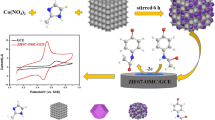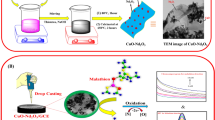Abstract
A facile and novel Ce-MOF@MWCNTs@ZnO-modified glassy carbon electrode was prepared through drop coating and used for accurate and sensitive electrochemical detection of carbendazim. The modification of ZnO nanospheres and Ce-based metal-organic frameworks (Ce-MOFs), which possess vast surface/bulk ratio, large surface area, and excellent catalytic ability, provided more active sites for reaction. The combination of multi-walled carbon nanotubes endowed the modified electrode with excellent conductivity and greatly accelerated the electron transfer. The promotion of electrochemical response and the significant improvement of peak current indicated the outstanding electrocatalytic ability of the modified electrode. The oxidation peak current of carbendazim which was measured by DPV in a potential range from 0.5 to 1.0 V produced a good linear relationship in the concentration ranges 0.05–10.0 μM and 10.0–50.0 μM under optimized experimental conditions. The detection limit was 13.2 nM (S/N = 3). The constructed electrode was successfully applied to the detection of carbendazim in Lithospermum and Glycyrrhiza uralensis real samples and exhibited satisfactory RSD (2.7–3.6% and 1.6–4.8%, respectively) and recovery (102–106% and 97.7–107%, respectively).
Graphical Abstract







Similar content being viewed by others
Data Availability
Data generated or analyzed during this study are included in this published article and its supplementary file.
References
Kalijadis A, Djordjevic J, Papp Z, Jokic B, Spasojevic V, Babic B, Trtic-Petrovic T (2017) A novel carbon paste electrode based on nitrogen-doped hydrothermal carbon for electrochemical determination of carbendazim. J Serb Chem Soc 82(11):1259–1272. https://doi.org/10.2298/jsc161228053k
Wang S, Su L, Wang L, Zhang D, Shen G, Ma Y (2020) Colorimetric determination of carbendazim based on the specific recognition of aptamer and the poly-diallyldimethylammonium chloride aggregation of gold nanoparticles. Spectrochim Acta A Mol Biomol Spectrosc 228:117809. https://doi.org/10.1016/j.saa.2019.117809
Xie Y, Gao F, Tu X, Ma X, Xu Q, Dai R, Huang X, Yu Y, Lu L (2019) Facile synthesis of MXene/electrochemically reduced graphene oxide composites and their application for electrochemical sensing of carbendazim. J Electrochem Soc 166(16):B1673–B1680. https://doi.org/10.1149/2.0091916jes
Bian L (2017) Electrochemical determination of carbendazim in water base on carbon dots modified glassy carbon electrode. Int J Electrochem Sc 12:3675–3685. https://doi.org/10.20964/2017.05.55
Gao X, Gao Y, Bian C, Ma H, Liu H (2019) Electroactive nanoporous gold driven electrochemical sensor for the simultaneous detection of carbendazim and methyl parathion. Electrochim Acta 310:78–85. https://doi.org/10.1016/j.electacta.2019.04.120
Feng S, Li Y, Zhang R, Li Y (2019) A novel electrochemical sensor based on molecularly imprinted polymer modified hollow N, S-Mo2C/C spheres for highly sensitive and selective carbendazim determination. Biosens Bioelectron 142:111491. https://doi.org/10.1016/j.bios.2019.111491
Salihu M, Ajayi BO, Adedara IA, Farombi EO (2017) 6-Gingerol-rich fraction prevents disruption of histomorphometry and marker enzymes of testicular function in carbendazim-treated rats. Andrologia 49(10). https://doi.org/10.1111/and.12782
Jin C, Zeng Z, Wang C, Luo T, Wang S, Zhou J, Ni Y, Fu Z, Jin Y (2018) Insights into a possible mechanism underlying the connection of carbendazim-induced lipid metabolism disorder and gut microbiota dysbiosis in mice. Toxicol Sci 166(2):382–393. https://doi.org/10.1093/toxsci/kfy205
McCarroll NE, Protzel A, Ioannou Y, Frank Stack H, Jackson MA, Waters MD, Dearfield KL (2002) A survey of EPA/OPP and open literature on selected pesticide chemicals: III Mutagenicity and carcinogenicity of benomyl and carbendazim. Mutat Res-Rev Mutat 512(1):1–35. https://doi.org/10.1016/S1383-5742(02)00026-1
Singh S, Singh N, Kumar V, Datta S, Wani AB, Singh D, Singh K, Singh J (2016) Toxicity, monitoring and biodegradation of the fungicide carbendazim. Environ Chem Lett 14(3):317–329. https://doi.org/10.1007/s10311-016-0566-2
Jiang J, Wu S, Wang Y, An X, Cai L, Zhao X, Wu C (2015) Carbendazim has the potential to induce oxidative stress, apoptosis, immunotoxicity and endocrine disruption during zebrafish larvae development. Toxicol In Vitro 29(7):1473–1481. https://doi.org/10.1016/j.tiv.2015.06.003
Wang SY, Shi XC, Liu FQ, Laborda P (2020) Chromatographic methods for detection and quantification of carbendazim in food. J Agric Food Chem 68(43):11880–11894. https://doi.org/10.1021/acs.jafc.0c04225
Scheel GL, Teixeira Tarley CR (2020) Simultaneous microextraction of carbendazim, fipronil and picoxystrobin in naturally and artificial occurring water bodies by water-induced supramolecular solvent and determination by HPLC-DAD. J Mol Liq 297:111897. https://doi.org/10.1016/j.molliq.2019.111897
Mahdavi V, Ghorbani-Paji F, Ramezani MK, Ghassempour A, Aboul-Enein HY (2019) Dissipation of carbendazim and its metabolites in cucumber using liquid chromatography tandem mass spectrometry. Int J Environ An Ch 99(10):968–976. https://doi.org/10.1080/03067319.2019.1617281
Bescós B, Orea JM, Montero C, González Ureña A, Weinkauf R, Boesl U, Schlag EW (1998) Spectroscopy of carbendazim in the UV region by resonant multiphoton ionisation. Chem Phys Lett 287(3):371–378. https://doi.org/10.1016/S0009-2614(98)00173-0
Li Q, Dou X, Zhao X, Zhang L, Luo J, Xing X, Yang M (2019) A gold/Fe3O4 nanocomposite for use in a surface plasmon resonance immunosensor for carbendazim. Microchim Acta 186(5):313. https://doi.org/10.1007/s00604-019-3402-0
Oliveira AM, Loureiro HC, de Jesus FF, de Jesus DP (2017) Electromembrane extraction and preconcentration of carbendazim and thiabendazole in water samples before capillary electrophoresis analysis. J Sep Sci 40(7):1532–1539. https://doi.org/10.1002/jssc.201601305
Xue J, Yang H, Li J, Ouyang H, Fu Z (2023) Smartphone-based pressure signal readout device combined with bidirectional immunochromatographic test strip for dual-analyte detection. Anal Chem 95(2):1359–1365. https://doi.org/10.1021/acs.analchem.2c04322
Wang L, Ahmad W, Wu J, Wang X, Chen Q, Ouyang Q (2023) Selective detection of carbendazim using a upconversion fluorescence sensor modified by biomimetic molecularly imprinted polymers. Spectrochim Acta A Mol Biomol Spectrosc 284:121457. https://doi.org/10.1016/j.saa.2022.121457
Liu D, Gong QF, Xu XX, Meng SY, Li YY, You TY (2023) Photoelectrochemical aptasensor based on cascade dual Z-scheme CdTe-polyaniline@MoS2 heterostructure for the sensitive carbendazim detection. J Electroanal Chem 930:117143. https://doi.org/10.1016/j.jelechem.2023.117143
Maximiano EM, de Lima F, Cardoso CAL, Arruda GJ (2018) Modification of carbon paste electrodes with recrystallized zeolite for simultaneous quantification of thiram and carbendazim in food samples and an agricultural formulation. Electrochim Acta 259:66–76. https://doi.org/10.1016/j.electacta.2017.10.162
Khoshbin Z, Davoodian N, Taghdisi SM, Abnous K (2022) Metal organic frameworks as advanced functional materials for aptasensor design. Spectrochim Acta A Mol Biomol Spectrosc 276:121251. https://doi.org/10.1016/j.saa.2022.121251
Gan T, Li J, Li H, Liu Y, Xu Z (2019) Synthesis of Au nanorod-embedded and graphene oxide-wrapped microporous ZIF-8 with high electrocatalytic activity for the sensing of pesticides. Nanoscale 11(16):7839–7849. https://doi.org/10.1039/c9nr01101c
Yang Y, Cheng J, Wang B, Guo Y, Dong X, Zhao J (2019) An amino-modified metal-organic framework (type UiO-66-NH2) loaded with cadmium(II) and lead(II) ions for simultaneous electrochemical immunosensing of triazophos and thiacloprid. Microchim Acta 186(2):101. https://doi.org/10.1007/s00604-018-3201-z
Zhang J, Xu X, Chen L (2018) An ultrasensitive electrochemical bisphenol A sensor based on hierarchical Ce-metal-organic framework modified with cetyltrimethylammonium bromide. Sensor Actuat B-Chem 261:425–433. https://doi.org/10.1016/j.snb.2018.01.170
Tu X, Xie Y, Ma X, Gao F, Gong L, Wang D, Lu L, Liu G, Yu Y, Huang X (2019) Highly stable reduced graphene oxide-encapsulated Ce-MOF composite as sensing material for electrochemically detecting dichlorophen. J Electroanal Chem 848:113268. https://doi.org/10.1016/j.jelechem.2019.113268
Wang X, Xu Y, Li Y, Li Y, Li Z, Zhang W, Zou X, Shi J, Huang X, Liu C, Li W (2021) Rapid detection of cadmium ions in meat by a multi-walled carbon nanotubes enhanced metal-organic framework modified electrochemical sensor. Food Chem 357:129762. https://doi.org/10.1016/j.foodchem.2021.129762
Zhou Y, Cui R, Dang Y, Li Y, Zou Y (2019) Doping controlled oxygen vacancies of ZnWO4 as a novel and effective sensing platform for carbendazim and biomolecule. Sensor Actuat B-Chem 296:126680. https://doi.org/10.1016/j.snb.2019.126680
Sadeghi R, Karimi-Maleh H, Bahari A, Taghavi M (2013) A novel biosensor based on ZnO nanoparticle/1,3-dipropylimidazolium bromide ionic liquid-modified carbon paste electrode for square-wave voltammetric determination of epinephrine. Phys Chem Liq 51(6):704–714. https://doi.org/10.1080/00319104.2013.782547
Ge C, Li H, Li M, Li C, Wu X, Yang B (2015) Synthesis of a ZnO nanorod/CVD graphene composite for simultaneous sensing of dihydroxybenzene isomers. Carbon 95:1–9. https://doi.org/10.1016/j.carbon.2015.08.006
Guo Z, Yang F, Yang R, Sun L, Li Y, Xu J (2021) Preparation of novel ZnO-NP@Zn-MOF-74 composites for simultaneous removal of copper and tetracycline from aqueous solution. Sep Purif Technol 274:118949. https://doi.org/10.1016/j.seppur.2021.118949
Zhou N, Ma Y, Hu B, He L, Wang S, Zhang Z, Lu S (2019) Construction of Ce-MOF@COF hybrid nanostructure: label-free aptasensor for the ultrasensitive detection of oxytetracycline residues in aqueous solution environments. Biosens Bioelectron 127:92–100. https://doi.org/10.1016/j.bios.2018.12.024
Zhao C, Ma C, Li W, Song Y, Hong C, Qi Y (2021) Differences in performance of immunosensors constructed based on CeO(2)-simulating auxiliary enzymes. ACS Biomater Sci Eng 7(3):1058–1064. https://doi.org/10.1021/acsbiomaterials.0c01680
Liu R, Li B, Li F, Dubovyk V, Chang Y, Li D, Ding K, Ran Q, Wang G, Zhao H (2022) A novel electrochemical sensor based on beta-cyclodextrin functionalized carbon nanosheets@carbon nanotubes for sensitive detection of bactericide carbendazim in apple juice. Food Chem 384:132573. https://doi.org/10.1016/j.foodchem.2022.132573
Balamurugan K, Karthik R, Chen S-M, Sukanya R, Thasma Subramanian B, Biju VMN, Shim J-J, Breslin CB (2022) Heterostructures of mixed metal oxides (ZnMnO3/ZnO) synthesized by a wet-chemical approach and their application for the electrochemical detection of the drug chlorpromazine. Compos Part B-Eng 236:109822. https://doi.org/10.1016/j.compositesb.2022.109822
He B, Yan X (2019) An amperometric zearalenone aptasensor based on signal amplification by using a composite prepared from porous platinum nanotubes, gold nanoparticles and thionine-labelled graphene oxide. Microchim Acta 186(6):383. https://doi.org/10.1007/s00604-019-3500-z
Yukird J, Kongsittikul P, Qin J, Chailapakul O, Rodthongkum N (2018) ZnO@graphene nanocomposite modified electrode for sensitive and simultaneous detection of Cd (II) and Pb (II). Synthetic met 245:251–259. https://doi.org/10.1016/j.synthmet.2018.09.012
Acknowledgements
The authors gratefully acknowledge financial support from the National Natural Science Foundation of China (NSFC, Grant No. 21005021), Natural Science Foundation of Guangdong Province (No. 2021A1515011410), and Guangdong Provincial Science and Technology Project (No. 2016B030303002).
Author information
Authors and Affiliations
Corresponding authors
Ethics declarations
Conflict of interest
The authors declare no competing interests.
Additional information
Publisher’s note
Springer Nature remains neutral with regard to jurisdictional claims in published maps and institutional affiliations.
Supplementary information
ESM 1
(DOCX 1939 kb)
Rights and permissions
Springer Nature or its licensor (e.g. a society or other partner) holds exclusive rights to this article under a publishing agreement with the author(s) or other rightsholder(s); author self-archiving of the accepted manuscript version of this article is solely governed by the terms of such publishing agreement and applicable law.
About this article
Cite this article
Lai, H., Ming, P., Liu, Y. et al. MWCNTs and ZnO-based Ce-MOF nanocomposites as enhanced sensing platform for electrochemical detection of carbendazim in Chinese traditional herbs samples. Microchim Acta 190, 281 (2023). https://doi.org/10.1007/s00604-023-05869-x
Received:
Accepted:
Published:
DOI: https://doi.org/10.1007/s00604-023-05869-x




